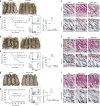Alopecia areata is driven by cytotoxic T lymphocytes and is reversed by JAK inhibition
- PMID: 25129481
- PMCID: PMC4362521
- DOI: 10.1038/nm.3645
Alopecia areata is driven by cytotoxic T lymphocytes and is reversed by JAK inhibition
Abstract
Alopecia areata (AA) is a common autoimmune disease resulting from damage of the hair follicle by T cells. The immune pathways required for autoreactive T cell activation in AA are not defined limiting clinical development of rational targeted therapies. Genome-wide association studies (GWAS) implicated ligands for the NKG2D receptor (product of the KLRK1 gene) in disease pathogenesis. Here, we show that cytotoxic CD8(+)NKG2D(+) T cells are both necessary and sufficient for the induction of AA in mouse models of disease. Global transcriptional profiling of mouse and human AA skin revealed gene expression signatures indicative of cytotoxic T cell infiltration, an interferon-γ (IFN-γ) response and upregulation of several γ-chain (γc) cytokines known to promote the activation and survival of IFN-γ-producing CD8(+)NKG2D(+) effector T cells. Therapeutically, antibody-mediated blockade of IFN-γ, interleukin-2 (IL-2) or interleukin-15 receptor β (IL-15Rβ) prevented disease development, reducing the accumulation of CD8(+)NKG2D(+) T cells in the skin and the dermal IFN response in a mouse model of AA. Systemically administered pharmacological inhibitors of Janus kinase (JAK) family protein tyrosine kinases, downstream effectors of the IFN-γ and γc cytokine receptors, eliminated the IFN signature and prevented the development of AA, while topical administration promoted hair regrowth and reversed established disease. Notably, three patients treated with oral ruxolitinib, an inhibitor of JAK1 and JAK2, achieved near-complete hair regrowth within 5 months of treatment, suggesting the potential clinical utility of JAK inhibition in human AA.
Conflict of interest statement
The authors declare competing financial interests: details are available in the online version of the paper.
Figures




Comment in
-
Inhibiting Janus kinases to treat alopecia areata.Nat Med. 2014 Sep;20(9):989-90. doi: 10.1038/nm.3685. Nat Med. 2014. PMID: 25198048
-
Autoimmune disease: Getting to the root of hair loss in alopecia.Nat Rev Drug Discov. 2014 Oct;13(10):724-5. doi: 10.1038/nrd4443. Epub 2014 Sep 19. Nat Rev Drug Discov. 2014. PMID: 25233992 No abstract available.
References
-
- Gilhar A, Etzioni A, Paus R. Alopecia areata. N Engl J Med. 2012;366:1515–1525. - PubMed
-
- McElwee KJ, et al. Transfer of CD8+ cells induces localized hair loss whereas CD4+/CD25− cells promote systemic alopecia areata and CD4+/CD25+cells blockade disease onset in the C3H/HeJ mouse model. J Invest Dermatol. 2005;124:947–957. - PubMed
-
- Ito T, et al. Maintenance of hair follicle immune privilege is linked to prevention of NK cell attack. J Invest Dermatol. 2008;128:1196–1206. - PubMed
Publication types
MeSH terms
Substances
Associated data
- Actions
- Actions
- Actions
- Actions
- Actions
- Actions
Grants and funding
- S10 RR027050/RR/NCRR NIH HHS/United States
- R21 AR061881/AR/NIAMS NIH HHS/United States
- T32 GM007088/GM/NIGMS NIH HHS/United States
- P30AR044535/AR/NIAMS NIH HHS/United States
- T32GM082271/GM/NIGMS NIH HHS/United States
- R01 AR056016/AR/NIAMS NIH HHS/United States
- R21AR061881/AR/NIAMS NIH HHS/United States
- T32 GM082771/GM/NIGMS NIH HHS/United States
- R01AR056016/AR/NIAMS NIH HHS/United States
- P30 AR044535/AR/NIAMS NIH HHS/United States
- U01 AR067173/AR/NIAMS NIH HHS/United States
- S10RR027050/RR/NCRR NIH HHS/United States
LinkOut - more resources
Full Text Sources
Other Literature Sources
Medical
Molecular Biology Databases
Research Materials
Miscellaneous

